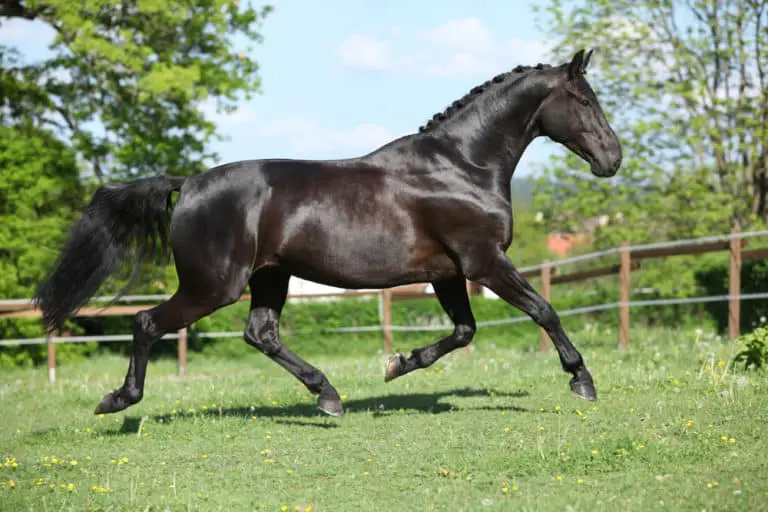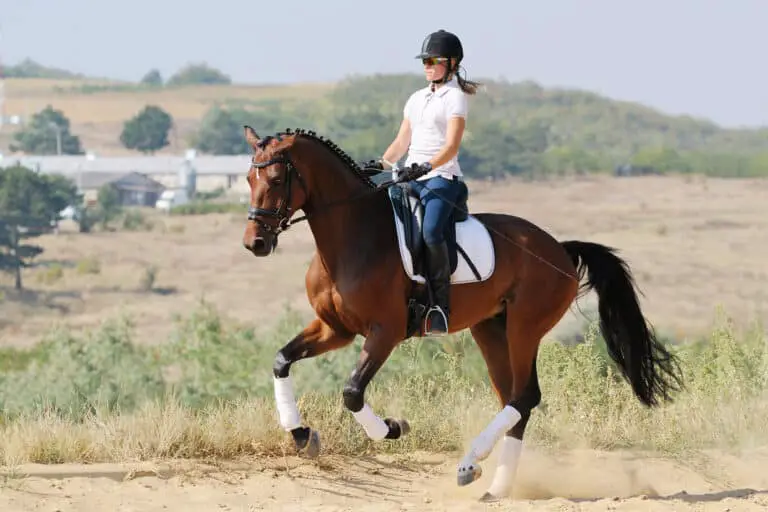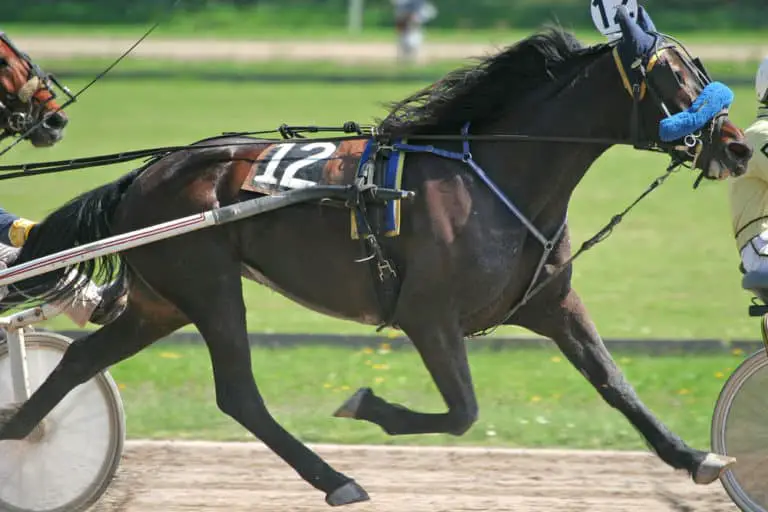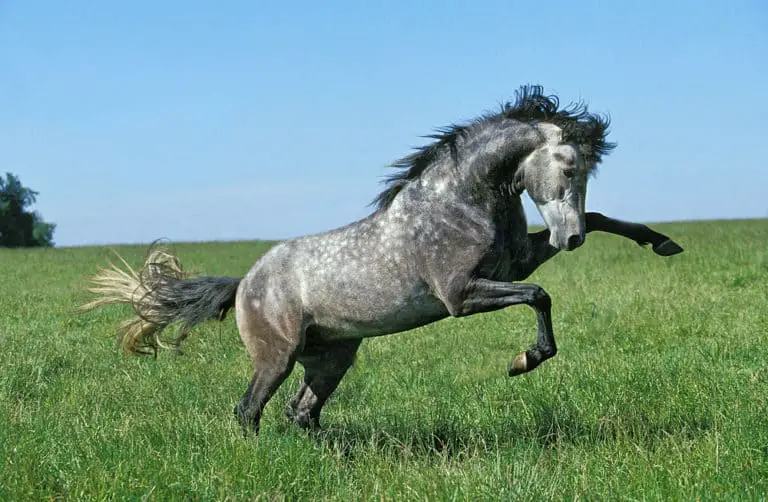Horse Riding Accident Statistics in 2024 (Latest U.S. Data)
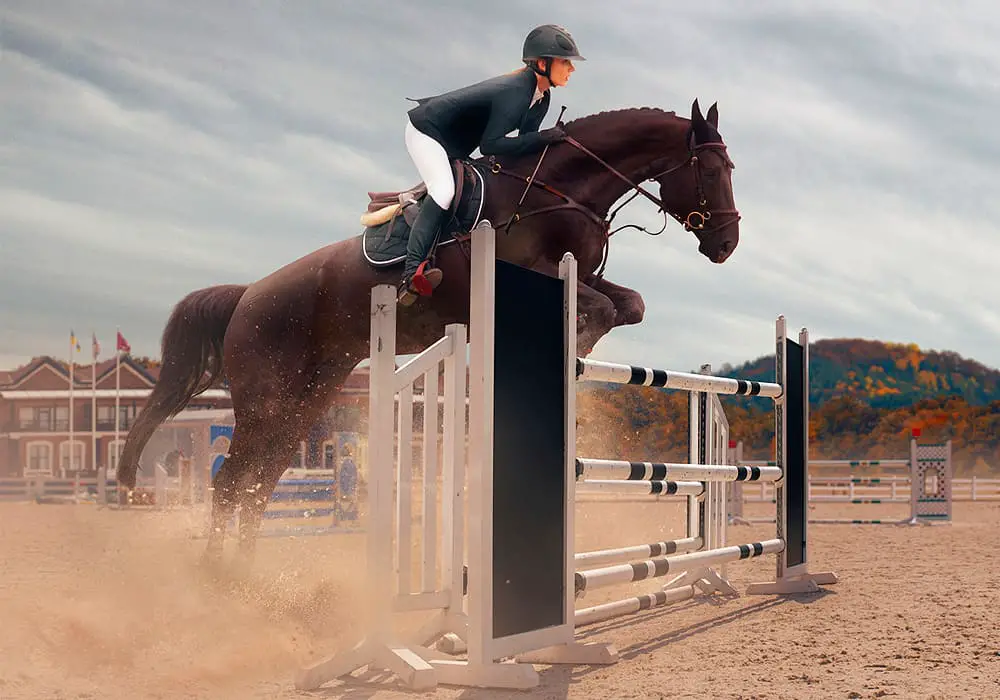
Horseback riding is extremely popular among Americans, but it comes with a potential price.
The “everyone falls off the horse” motto shouldn’t be an accepted way of learning and needs to be taken seriously.
Although horses’ behavior can be unpredictable, riders can do a lot to minimize risks. Here’s what the latest research tells us about horse riding accident statistics.
Horse Riding Accident Statistics
Highlights of horse riding injuries:
- Horseback riding is more dangerous than skiing and motorcycling.
- 74.83% of equestrian deaths are caused by head and neck injuries.
- 2 out of 3 horse riding injuries can be prevented.
- Horseback riding is the leading cause of sports-related traumatic brain injuries.
- Lifetime cost for acute head injury can be up to $3 million.
- Wearing a riding helmet reduces the risk of severe head injury by 50%.
- 81% of equestrians get injured at some point in their riding career.
- Over 100,000 horse riding-related accidents occur yearly in the U.S.
- 83.4% of horse riding injuries are caused by the rider falling off the horse.
1. Horseback riding is more dangerous than skiing and motorcycling.
Some sports activities are way more dangerous than others, but we are still drawn to them thanks to the thrill, adrenaline, and excitement they add to our lives.
According to the research (2002) on horseback riding danger statistics, the rate of hospital admissions for equestrians is 11.8/1000 riders or, assuming one hour per day riding on average, 0.49/1000 hours of riding. (1)
| Horseback Riding Hospital Admission | Skiing Emergency Dept. | Motorcycle Riding Hospital Admission |
| 0.49/1000 hours | 0.60/1000 hours | 0.14/1000 hours |
For comparison, the injury rate for motorcycle riding is 0.14/1000 hours of riding and the injury rate for skiing is 2.91/1000 days, or assuming five hours/day skiing, 0.6/1000 hours.
Since admission to the hospital would indicate more serious injury than a visit to the emergency department, the study concluded that horse riding is more dangerous than either skiing or motorcycling.
The second study conducted in 2021 on U.S. horse riding injury statistics found that the risk of hospital admission from equestrian injuries is higher than motorcycling, skiing, and football. (2)
The research analyzed the U.S. National Trauma Data Bank equestrian injuries data from 2007 to 2016 and found that 88% of all patients who were presented to the hospital were admitted.
This proportion of hospital admissions from equestrian injuries was 3.5 times higher than motorcycle riding.
When compared for hours of activity, horseback riding resulted in a higher proportion of hospital admission than skiing.
The third study from 2007 analyzed 10 years of major traumatic equestrian injuries and concluded that horseback riding is more dangerous than motorcycle riding, skiing, football, and rugby. (3)
Several studies over decades are concluding that the rate of serious injury per number of riding hours is higher than motorcycling, skiing, or football.
On average, motorcyclists experience an injury once every 7,000 hours of riding, while equestrians have a serious accident once every 350 hours. (4)
Equipped with all this knowledge, it’s essential to understand the risks that come with each sport and to promote the use of appropriate safety equipment and education to minimize the risks where possible.
2. 74.83% of equestrian deaths are caused by head and neck injuries.
According to research (2021) on horseback riding deaths statistics, head and neck injuries are the largest contributor to mortality in equestrian injuries. (2)
The study analyzed National Trauma Data Bank data between 10 year period (2007 to 2016) and found that during the study period, 74.83% of equestrian deaths were caused by head and neck injuries.
| Deaths by Head & Neck Injuries | Deaths by Thoracic Injuries | Deaths by Abdominal Injuries | Deaths by Extremity Injuries |
| 74.83% | 18.44% | 5.31% | 1.42% |
Thoracic injuries were the second highest with 18.44% and abdominal injuries caused the third-highest number of deaths with 5.31%.
Head and neck injuries were significantly associated with longer ICU LOS and more ventilator days.
The horse riding deaths statistics also found that head and neck injuries were also associated with a ninefold increase in the risk of death.
This finding coincides with previous data indicating greater mortality from head and neck injuries in fatal horse accidents.
3. 2 out of 3 horse riding injuries can be prevented.
Horseback riding accidents occur because of many reasons, anything from the riders’ behavior to actions of the horses to third-party factors.
The reality is that many horse riding injuries can be prevented.
A 2018 research on horseback riding injuries statistics found that the majority of horseback riding injuries could have been prevented and injuries were due to rider or handler error. (5)
| #1 Avoidable Cause | #2 Avoidable Cause | #3 Avoidable Cause |
| Broken Tack | Slipped Saddle | No Safety Check |
The study analyzed horseback riding accidents and injuries found that 66% of injuries were preventable.
This means 2 out of 3 horse riding injuries can be prevented, which itself is a positive discovery.
The top three most avoidable causes of injuries were broken tack (Z-score 1.937), slipped saddle(Z-score 1.859), and absent safety check(Z-score 1.859).
Oftentimes equestrians might feel more confident than their experiences and ride a green or new horse when they do not have the necessary skillset.
It’s also reported that professional equestrians experience more serious accidents, although less frequent, generally due to more complex causes and increased level of difficulty of their activity.
Meaning riders with more experience are actually more likely to become injured.
The research suggests that horse and rider suitability is the main area where coaches and instructors may assist in the prevention of the most common equestrian injuries.
This current finding that 66% of accidents are preventable is very similar to two other studies by Mayberry (6) and Ball (7) in 2007, both reporting 64% of horse riding injuries were preventable.
4. Horseback riding is the leading cause of sports-related traumatic brain injuries.
According to the Centers for Disease Control and Prevention (CDC), sports-related traumatic brain injury (TBI) is affecting 1.7 to 3.8 million people annually in the U.S. (4)
A 2016 study by the journal Neurological Focus found that horse-related accidents cause the most traumatic brain injuries in the U.S. (8)
| Equestrian Sports | Fall/Interpersonal Contact | Roller Sports | Skiing and Snowboarding | Aquatic Sports |
| 45.2% | 20.3% | 19.0% | 12.0% | 3.5% |
The study analyzed the National Trauma Data Bank data on a 10-year period (2003 to 2012) across 5 sporting categories – fall or interpersonal contact (FIC), roller sports, skiing/snowboarding, equestrian sports, and aquatic sports.
Horseback riding injuries contributed the highest number 45.2% of TBI among adults. The second highest was FIC 20.3% and roller sports 19% of TBIs.
Understanding the likelihood of TBIs, it’s important to focus on increasing TBI awareness and helmet use, especially in equestrian sports.
5. Lifetime cost for acute head injury can be up to $3 million.
Research on horse riding danger statistics suggests that little work has been done to measure the real costs of equestrian injuries. (2)
The data shows that the long-term rehabilitation costs of equestrian injuries are high.
According to research, for the average adult with brain injury, the unemployment rate two years after diagnosis is 60%, compared to the national unemployment average of 5.1%. (9)
| Lifetime Cost of Traumatic Brain Injury | Avg. Brain Injury Unemployment Rate | Avg. National Unemployment Rate |
| $85,000 – $3 million | 60% | 5.1% |
What makes things difficult is the high cost of treatment. The lifetime costs for a traumatic brain injury are estimated to run from $85,000 to $3 million.
The high-cost head injury treatment can make the needed treatment inaccessible for some patients.
Another research analyzed equestrian accidents between 2001 and 2008 and found that the mean hospital charge was $29,800 for a total of $6.9 million. (10)
The study concluded that equestrian injury is costly, disabling, and frequently preventable.
6. Wearing a riding helmet reduces the risk of severe head injury by 50%.
Research on horse helmet safety statistics suggests that a large fraction of riders involved in equestrian injuries were not wearing helmets at the time of their accident. (2)
At the same time, approximately 20% of all riders sustain a head injury, mostly soft tissue injuries and concussions. (11)
The equestrian injury statistics show that the use of riding helmets is low while the likelihood of head injuries is high.
But what are the most common reasons why horse riders don’t want to wear a riding helmet? Researchers asked horse riders who don’t wear riding helmets for their reasons and here are the most popular answers. (12)
| Don’t Want to | Forgot to Wear | Helmet is Too Hot | Uncomfortable |
| 41.4% riders | 36.3% riders | 44.3% riders | 37.5% riders |
The research found that riding helmets are still under-utilized by the horse riding community, with as few as 9% of adult riders wearing helmets on a regular basis. (12)
The study found that Modern American Society for Testing and Materials/Safety Equipment Institute-approved helmets have reduced riding-related head injuries by 30% and severe head injuries by 50%.
According to the New England Journal of Medicine, helmets can reduce head and brain injuries by 85 percent. (4)
According to another research, the data suggest that helmets reduce the severity of the head injury. (13)
7. 81% of equestrians get injured at some point in their riding career.
According to research on equestrian accident statistics, the injury rate for horse riding is 3.7 injuries per 1,000 hours of participation. (12)
At first glance, this might not be that high rate, but several studies have found that horse-related injuries presented at hospitals tend to be severe.
| Horse Riding Injury Rate | Horseback Riding Injuries | Serious Injuries With Hospitalization |
| 3.7 per 1,000 hours | 81% equestrians | 21% equestrians |
For example, when comparing horseback riding to hockey, horseback riding-related injuries are more likely to require hospitalization.
The data suggest that 81% of equestrians experience horseback riding injuries at some point during their riding career and 21% are injured, seriously requiring hospitalization.
There is some research suggesting that experienced riders have a higher likelihood of injuries. (2)
This is mostly caused by experienced riders taking more risks or performing techniques that are increasing the risk of horse incidents.
Research also suggests that more experienced riders were less likely to wear a helmet, although this raises the risk for injuries requiring hospitalization or causing permanent disability.
8. Over 100,000 horse riding-related accidents occur yearly in the U.S.
Although horse riding is extremely popular in the U.S., there’s no official number of accidents known.
Research on horseback riding accident statistics has concluded that horse riding accidents have been found to affect approximately 35.7 persons per 100,000 population every year in the USA. (11)
| Accident Rate per Population | Total Accidents per Year | Mortality Rate per Riders | Total Fatal Accidents per Year |
| 35.7 / 100,000 | 117,632 | 1 / 10,000 | 710 |
According to the World Bank, in 2020, the U.S. population was 329.5 million people. (15)
Based on this, we can do a rough estimation: 329.5 million Americans / 100,000 * 35.7 persons = 117,631.5 horse riding related accidents per year.
Meaning there are over 100,000 horse riding-related accidents in the U.S. each year. (16)
Research also shows that when it comes to horse-related deaths, about 1 out of every 10,000 horse riders die each year in a horse-related accident. (1)
According to The Equestrian Channel, approximately 7.1 Million Americans go horseback riding each year. (17)
Based on this, we can do another rough estimation: 7.1 million Americans / 10,000 * 1 death = 710 horse riding-related deaths per year.
Meaning, there are approximately 710 horse fatal horse riding accidents in the U.S. each year.
Of course, these numbers are not official and definitive, but they do give us rough numbers to give us an idea of the current situation.
9. 83.4% of horse riding injuries are caused by the rider falling off the horse.
Horse riding and handling can both be quite dangerous.
According to research published in 2018, the great majority of accidents are caused by riders falling off horses. (5)
| #1 Cause of Falling | #2 Cause of Falling | #3 Cause of Falling | #4 Cause of Falling |
| Spooked Horse | Human Error | Green Horse | New Horse |
The purpose of the research was to evaluate the most common causes of horse-related accidents, their severity, and how to prevent them.
The study found that 83.4% of accidents happen after the rider falls off the horse. This includes fell off horse, bucked off, knocked down, horse fell on rider, horse fell with rider, and dragged.
At the same time, being kicked or stepped on by a horse happens approximately 19.5% of the time. (6)
These findings are supported by another study published in 2003, reported that the majority of injuries (67%) admitted in their hospital was caused by horseback riding falls, followed by being kicked by a horse (16%) and that most accidents occur in public places (55%). (18)
References
- Sorli JM. Equestrian injuries: a five year review of hospital admissions in British Columbia, Canada. Injury Prevention 2000;6:59-61. Link
- Mutore K, Lim J, Fofana D, et al Hearing hoofbeats? Think head and neck trauma: a 10-year NTDB analysis of equestrian-related trauma in the USA. Trauma Surgery & Acute Care Open 2021;6:e000728. doi: 10.1136/tsaco-2021-000728. CC BY-NC 4.0 Link
- Chad G. Ball M.D., M.Sc., Jill E. Ball B.H.Sc.O.T., Andrew W. Kirkpatrick M.D., F.R.C.S.C., F.A.C.S., Robert H.Mulloy M.D., F.R.C.S.C. 2007. Equestrian injuries: incidence, injury patterns, and risk factors for 10 years of major traumatic injuries. Link
- American Association of Neurological Surgeons, Nitin Agarwal, MD, Rut Thakkar, Khoi Than, MD, FAANS. 2021. A Neurosurgeon Explains: Sports-related Head Injury. Link
- Fernanda Camargo, William R. Gombeski Jr, Polly Barger, Connie Jehlik, Holly Wiemers, James Mead & Amy Lawyer | Pedro González-Redondo (Reviewing Editor) (2018) Horse-related injuries: Causes, preventability, and where educational efforts should be focused, Cogent Food & Agriculture, 4:1, DOI: 10.1080/23311932.2018.1432168. Link
- Mayberry, John C. MD; Pearson, Tuesday E. BS; Wiger, Kerry J. RN; Diggs, Brian S. PhD; Mullins, Richard J. MD. The Journal of Trauma: Injury, Infection, and Critical Care: March 2007 – Volume 62 – Issue 3 – p 735-739. DOI: 10.1097/ta.0b013e318031b5d4. Link
- Chad G. Ball, Jill E. Ball, Andrew W. Kirkpatrick, Robert H. Mulloy. Equestrian injuries: incidence, injury patterns, and risk factors for 10 years of major traumatic injuries, The American Journal of Surgery, Volume 193, Issue 5, 2007. Link
- Ethan A. Winkler MD, PhD, John K. Yue BA, John F. Burke MD, PhD, Andrew K. Chan MD, Sanjay S. Dhall MD, Mitchel S. Berger MD, Geoffrey T. Manley MD, PhD, Phiroz E. Tarapore MD. 2016. Adult sports-related traumatic brain injury in United States trauma centers. Link
- Chandi Edmonds, Next Avenue. 2015. The Steep Cost of Brain Injury Recovery. Link
- Kristina Guyton, B.A., Emily Houchen-Wise, B.S., Ellen Peck, R.N., John Mayberry, M.D. 2013. Equestrian Injury is Costly, Disabling, and Frequently Preventable: The Imperative for Improved Safety Awareness. Link
- Lauren Meredith, Robert Ekman, Robert Thomson. 2018. Horse-related incidents and factors for predicting injuries to the head. CC BY-NC 4.0. Link
- Ansley Grimes Stanfill, Kayla Wynja, Xueyuan Cao, Drew Prescott, Sarah Shore, Brandon Baughman, Anthony Oddo, Jack W Tsao. 2020. Helmet use in equestrian athletes: opportunities for intervention. Link
- Connor, T.A., Clark, J.M., Jayamohan, J. et al. Do equestrian helmets prevent concussion? A retrospective analysis of head injuries and helmet damage from real-world equestrian accidents. Sports Med – Open 5, 19 (2019). DOI: 10.1186/s40798-019-0193-0. Link
- Sara L. Mastellar, PhD, Equine Faculty, Ohio State ATI. 2020. Equestrian Injury Statistics. Link
- The World Bank. 2021. Link
- Thomas KE, Annest JL, Gilchrist J, Bixby-Hammett DM. Non-fatal horse related injuries treated in emergency departments in the United States, 2001-2003. Br J Sports Med. 2006 Jul;40(7):619-26. doi: 10.1136/bjsm.2006.025858. Epub 2006 Apr 12. PMID: 16611723; PMCID: PMC2564310. Link
- The Equestrian Channel. 2021. US Horse Industry Statistics. Link
- Fikri M Abu-Zidan, Sudhakar Rao. Factors affecting the severity of horse-related injuries, Injury, Volume 34, Issue 12, 2003, Pages 897-900, ISSN 0020-1383. Link
FAQ
What percent of horseback riders get injured?
81% of horseback riders get injured at some point in their riding career. The average horse riding injury rate is 35.6 persons per 100,000 population.
Is horse riding a high-risk sport?
Horseback riding is more dangerous than skiing and motorcycling. Horseback riding hospital admission rate is 0.49 per 1000 hours of riding, while motorcycle riding hospital admission rate is 0.14 per 1000 hours of riding.
What is the most common horse riding injury?
The most common horse riding injuries are head and neck injuries. Also, 74.83% of equestrian deaths are caused by head and neck injuries, 18.44% by thoracic injuries, 5.31% by abdominal injuries.
How often do horse accidents happen?
On average, horse riding accidents happen with 35.7 persons per 100,000 population.
How many people are hospitalized from horses?
The rate of hospital admissions for equestrians is 11.8/1000 riders. Based on the National Trauma Data Bank data, on average, 4,567 riders get hospitalized each year.
Can you ride horses in a bike helmet?
No, you should not. Horse riders should wear a specialized ASTM/SEI certified horse riding helmet.
Which is more dangerous horse vs. motorcycle riding?
Horseback riding is more dangerous than motorcycle riding. Horseback riding hospital admission rate is 0.49 per 1000 hours of riding, while motorcycle riding hospital admission rate is 0.14 per 1000 hours of riding.
Which is more dangerous skiing vs. horse riding?
Horseback riding is more dangerous than skiing. Horseback riding hospital admission rate is 0.49 per 1000 hours of riding while skiing emergency dept. rate is 0.6 per 1000 hours of riding. The research concludes that admission to the hospital indicates more serious injury than a visit to the emergency department.
How many deaths are caused by horseback riding?
About 1 out of every 10,000 horse riders die each year in a horse-related accident. It’s estimated that 710 horse riding-related deaths occur each year.

